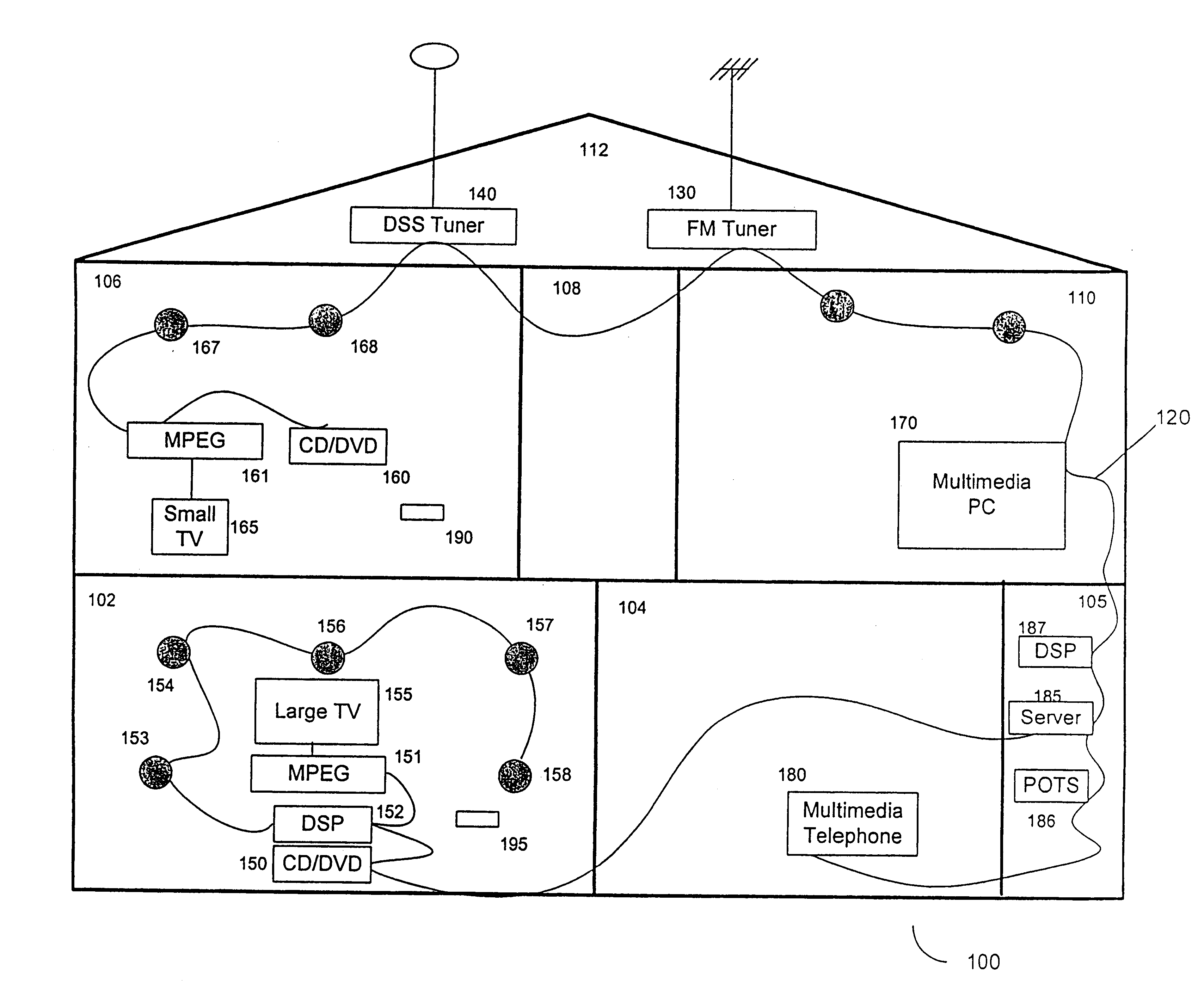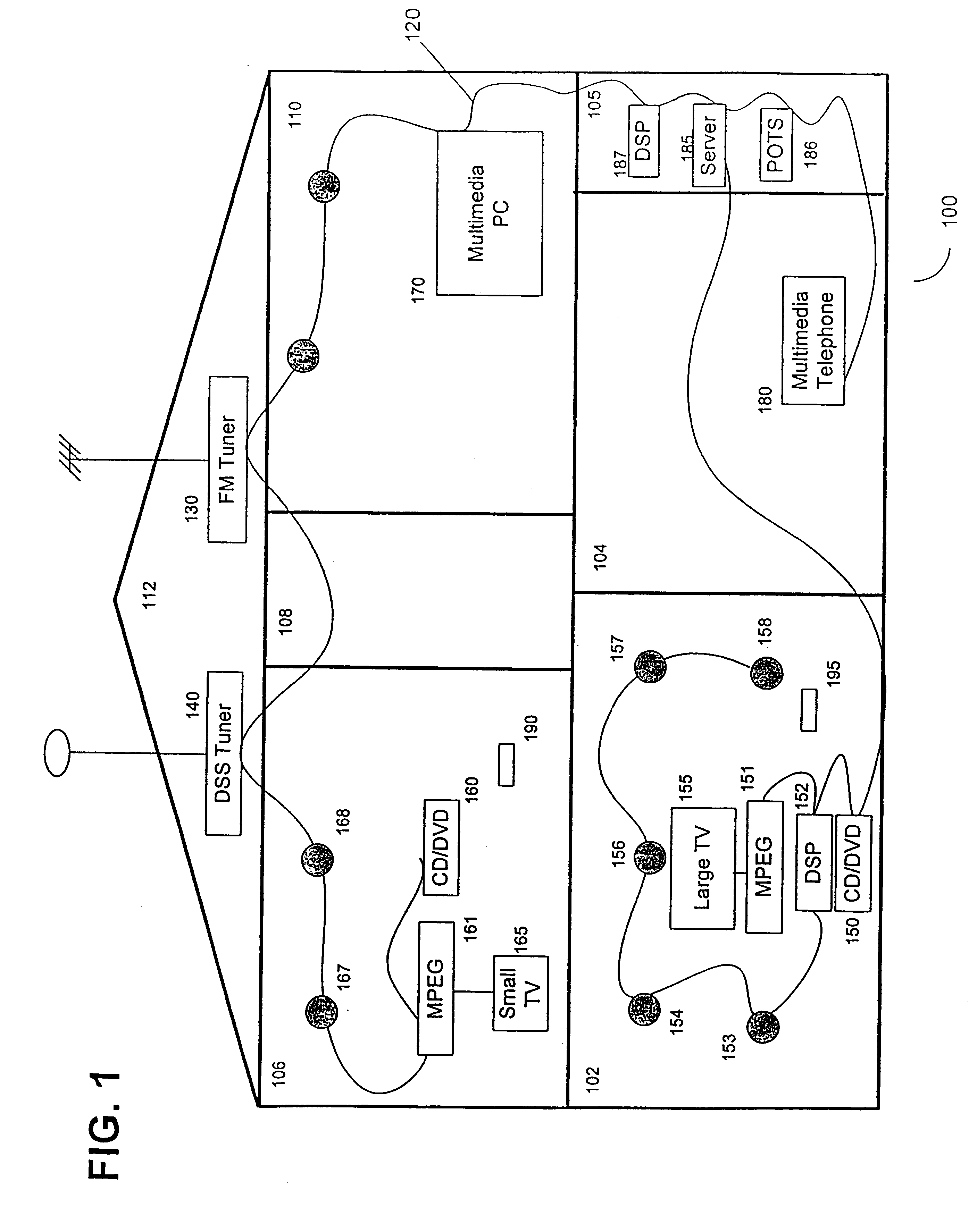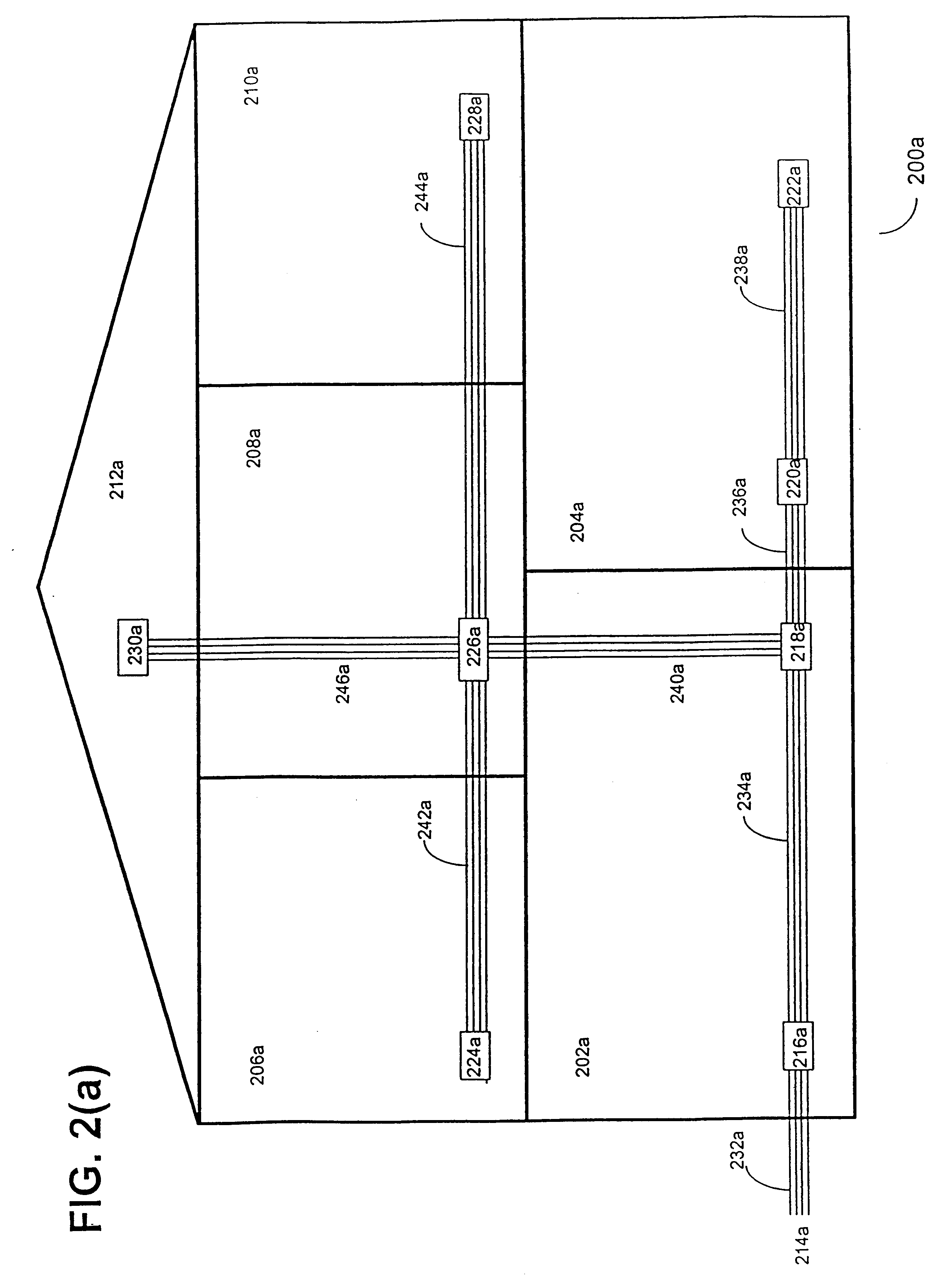Home theater systems, for example, effectively are limited to a
single room in a house, primarily due to the difficulty and expense of interconnecting devices.
Each source device, such as a
satellite receiver, VCR, laserdisc or
DVD player, typically is connected, by relatively expensive audio and video cables, to a "central"
preamplifier or other form of switching device, which is also connected to a main television / monitor as well as to one or more power amplifiers, which are in turn connected to various speakers throughout the room by dedicated (and also expensive) speaker cables.
Such a cabling scheme is both expensive and difficult to maintain.
Moreover, flexibility is limited, even with relatively high-end preamplifiers.
Only a limited number of source devices can be accommodated by any dedicated device
interconnection scheme.
It often is prohibitively expensive to replace a high-end
preamplifier merely because it will not accommodate the latest source device added to the
system.
Users therefore still may suffer the inconvenience of connecting and disconnecting cables manually to switch sources.
Moreover, even when all devices can be accommodated, the functionality of such home theater systems still remains limited.
As more source devices are added to a home theater system, the desire to
record programs becomes greater, as does the difficulty of successfully recording a desired program.
Few systems even permit more than one program to be recorded simultaneously.
The difficulty of controlling consumer electronics devices and systems stems from the fact that most devices are not designed to interoperate with one another.
User interfaces on universal remote controls are very limited.
Moreover, universal
remote control devices are extremely difficult to operate, and require extensive "
programming" to perform even simple functions, such as turning the system on and off, which may require a "program" to send multiple commands--i.e., one to each device.
The result is an expensive system that is complex to set up, use and maintain, even in a
single room.
Multi-room systems are even more rare, due to the expense of dedicated cabling solutions, and the additional inconvenience of distributing control over devices across rooms.
If VCRs, CD players and other source devices are physically located in different rooms of a house, the complexity of the "central"
preamplifier, designed for dedicated cabling to all source and destination devices, becomes unwieldy.
As a result, users improvise by providing redundant functionality.
Multiple preamplifiers, multiple VCRs, and multiple remote controls (often "programmed" uniquely for each room) are deployed, not necessarily because multiple devices are needed at any given time, but primarily because the alternative is too complex and expensive to be practical.
It is thus not surprising that such systems still are limited to hobbyists and high-end gadget-oriented users.
Current attempts to address the multi-room problem--i.e., "
home automation and
multimedia networks" exhibit a number of fundamental design flaws.
Custom installation of dedicated audio, video and speaker cables throughout a home is required, and often is prohibitively expensive and results in relatively
poor quality due to the degradation of analog signals propagating through multiple devices and extremely long cable runs.
Transmitting multiple audio / video channels over coaxial cables, power lines or via
radio frequency (RF) transmissions, degrades the signals significantly, and results in relatively low-quality audio and
video output. transmissions, degrades the signals significantly, and results in relatively low-quality audio and
video output.
Although some systems utilize existing unshielded
twisted pair (UTP) telephone wiring to carry analog audio and video signals, the analog modulation of source audio and video signals over UTP cables also produces relatively low-quality audio and
video output.
Moreover, such systems still require custom installation of such UTP cabling, because the parallel nature of existing telephone wiring topologies (discussed in greater detail below) is not compatible with the dedicated cabling schemes discussed above.
As a result, the expense and complexity of such systems increases exponentially compared with single-room home theater systems.
Although control over devices is improved (e.g., by a PC or other controller device, operating under
software or
firmware control), it is still limited, in essence, to the raw commands accepted by individual devices (e.g., by their remote controls).
Home automation networks, as a result of their separation of control and media distribution functionality, do not allow for sufficiently flexible control over streams of audio, video and other media, except at the most
basic level of switching from one source to another.
The result, as noted above, is a highly complex and expensive system that is difficult to set up, use and maintain.
Although the recent increase in popularity of the
home computer market has led to a great deal of discussion of home networks which merge general-purpose computing functionality with the consumer electronics devices found in home theaters, the solutions offered thus far do not seem to have advanced beyond the proposal stage.
Applying
local area network technology (e.g.,
Ethernet and TCP / IP network protocols) to consumer electronics devices raises a number of problems.
Although it appears advantageous to connect consumer electronics devices as generic nodes on a network, existing network protocols are far from optimized for real-time streams of
digital audio and video.
There are a number of obstacles to this
scenario, however, not the least of which is the apparent absence of an existing physical and logical infrastructure to carry the digital media streams.
Ethernet, for example, is not optimized to carry real-time continuous digital media streams.
It is an asynchronous, packet-based protocol that would add significant overhead to
digital audio and video samples, which require consistent and timely delivery, as opposed to the ability to "burst" packets of information at high speeds
on demand.
FireWire devices have limited "
plug and play" and "hot-pluggable" functionality.
Yet, doing so may interrupt (i.e., "
reboot") the network, and thus interrupt existing digital media streams, as the network reinitializes and reconfigures devices.
Thus, devices connected to two or more nodes cannot propagate incoming data while transmitting their own data.
From the above summary of the characteristics of FireWire, it is apparent that there are a number of obstacles to applying FireWire to real-
time distribution of digital media streams among consumer electronics devices, particularly in light of its essentially asynchronous and half-duplex nature.
The installation cost of a FireWire network of consumer electronics devices is likely to be quite high.
In addition to the high cost of installing FireWire, the cost of FireWire devices themselves is likely to be quite high, due primarily to the asynchronous nature of FireWire.
Moreover, almost double the audio data is required due to this buffering /
timestamping process, resulting in a significant loss of bandwidth.
This results in complex and expensive devices, due to the memory, buffers, counters and associated circuitry required to perform such functions.
The 8 kHz isochronous cycle simply is too slow for applications requiring CD-quality (44.1 kHz) audio.
The lack of asynchronous time base also results insignificant
clock jitter.
To account for this possibility, a
delay is encoded in the "cycle start"
signal, resulting in clock
jitter.
Moreover, additional
jitter results from the variable amount of time between the "cycle start" and the actual start of a specific device's subactions, requiring each device to maintain its own timing register to account for this source of jitter.
Yet, they add significant cost and complexity to every device attached to a FireWire
bus.
This could be a significant obstacle to acceptance of FireWire for anything beyond relatively high-end computer peripherals and the most expensive consumer electronics devices, such as HDTV or digital camcorders.
For applications requiring real-time delivery of continuous digital media streams, FireWire has additional problems.
One significant limitation to FireWire is the total length of the connecting cable, which is limited in the current specification to 4.5 meters (unless extremely expensive
fiber optic or other alternative cables are used).
This
short length is a significant limitation even within a single room used for a typical home theater system; and is prohibitive in the context of a house-wide application, such as a home telephone PBX or multi-room
digital audio and video
distribution system.
Even if repeaters could be accommodated, such devices would be relatively expensive, and would contribute to FireWire's 64-device limitation.
Such a
route would be extremely complex, requiring knowledge of data types to reassemble packets, buffering of variable-length packets, etc.
In addition to being expensive, such a
router would impose variable-length delays, making it extremely difficult, for example, to synchronize two speakers receiving information from a source device via the
router.
Another problem with FireWire devices in the context of a network of consumer electronics devices is that no mechanism exists to enable such devices to be truly hot-pluggable.
The FireWire
bus will reset whenever a device is added or removed, resulting in an interruption (however short) to all existing data streams.
The FireWire specification contains no provision for a
router or other device to isolate a particular device or chain of devices from the rest of the network, such that the FireWire
bus need not reset, and thus disrupt, the entire network when a device is added to or removed from this isolated
network segment or zone.
The lack of static device IDs also creates problems.
It simply is not optimized for distributing real-time continuous digital media streams among consumer electronics devices in a network environment.
Yet,
synchronous network protocols (as discussed below) have not been optimized or adapted for use with consumer electronics devices to enable the distribution of digital media streams in a manner that overcomes the limitations noted above.
In the context of transmitting digital media streams, however, certain data streams require more bandwidth than others.
This problem is exacerbated when asynchronously distributed variable bit-rate data, such as MPEG2 compressed video, must also be accommodated.
TDMA network technology provides no solution to either of these problems.
TDMA devices are left with a single fixed-width channel which is not well suited for accommodating either multiple real-time
continuous data types having differing bandwidth requirements, or an
asynchronous data type having bandwidth requirements that vary over time.
Moreover, that time slice might charge whenever a
new device is added to or removed from the network.
Thus, a device cannot guarantee consistent delivery of particular data, despite the synchronous nature of TDMA.
Yet, existing ring networks suffer from many of the same deficiencies discussed above.
Thus, such networks cannot guarantee consistent delivery of real-time continuous digital media streams.
Information therefore will not always propagate through a device at a consistent rate, due to the difference between the transmit and receive oscillators within a device, among other factors.
FDDI devices compensate for this difference with an "elasticity buffer" which avoids losing data, but does not guarantee consistent delivery of data.
For example, if a device receives data "late," it will transmit that data late.
Thus, FDDI devices also cannot guarantee consistent delivery of data such as real-time continuous digital media streams.
They are optimized for high
throughput, but not for consistent, synchronous delivery of data.
 Login to View More
Login to View More  Login to View More
Login to View More 


